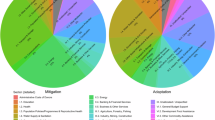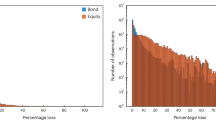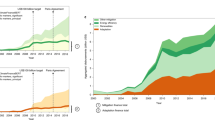Abstract
Controversy remains over the climate consistency of finance flows despite its centrality in the Paris Agreement (Article 2.1(c)). Two main interpretations dispute the goal’s reach, threatening its transformational potential. If left unresolved, the controversy may also mask trade-offs, allowing for unintentional harm to countries already vulnerable to climate change. Here we build on four methods to show that Art. 2.1(c) comprises a new meaning of ‘finance’ under the United Nations negotiations. In contrast to climate finance provision to developing countries (Art. 9), the climate consistency of finance flows represents a purpose that relies on support and action to transform the global financial system. Implementation of Art. 2.1(c) requires engagement by governments and non-state actors, including the financial sector. While solutions for Art. 2.1(c) will need to be adequate for countries’ contexts, accounting of trade-offs should ensure some level of convergence towards a global, timely and equitable progress towards climate consistency of finance flows.
This is a preview of subscription content, access via your institution
Access options
Access Nature and 54 other Nature Portfolio journals
Get Nature+, our best-value online-access subscription
$32.99 / 30 days
cancel any time
Subscribe to this journal
Receive 12 print issues and online access
$259.00 per year
only $21.58 per issue
Buy this article
- Purchase on SpringerLink
- Instant access to full article PDF
Prices may be subject to local taxes which are calculated during checkout




Similar content being viewed by others
Data availability
With the exception of interviews, all data used to support the results reported in this paper are listed in the Supplementary tables and Supplementary Data 1, and are available publicly on the webpage of the UNFCCC (https://unfccc.int/). Due to confidentiality agreements with respondents, transcriptions and other data related to interviews are stored locally and are not public. Some anonymized metadata such as regional, country of origin and gender balance of interviewees can be obtained from the corresponding author on reasonable request.
References
Gomez-Echeverri, L. The changing geopolitics of climate change finance. Clim. Policy 13, 632–648 (2013).
Pauw, W. P., Castro, P., Pickering, J. & Bhasin, S. Conditional nationally determined contributions in the Paris Agreement: foothold for equity or Achilles heel? Clim. Policy 20, 468–484 (2019).
Zahar, A. The Paris Agreement and the gradual development of a law on climate finance. Clim. Law 6, 75–90 (2016).
Ngwadla, X. & El-Bakri, S. The Global Goal for Adaptation under the Paris Agreement: Putting Ideas into Action (Climate and Development Knowledge Network, 2016).
Ghaleigh, N. S. Paris Agreement, Article 2: Aims, Objectives and Principles Research Paper No. 2020/02 (Edinburgh School of Law, 2020).
Gifford, L. & Knudson, C. Climate finance justice: international perspectives on climate policy, social justice, and capital. Climatic Change 161, 243–249 (2020).
Pauw, W. P., Klein, R. J. T., Vellinga, P. & Biermann, F. Private finance for adaptation: Do private realities meet public ambitions? Climatic Change 134, 489–503 (2016).
Hansen, G., Eckstein, D., Weischer, L. & Bals, C. Shifting the Trillions: The Role of the G20 in Making Financial Flows Consistent with Global Long-term Climate Goals (Germanwatch, 2017).
Whitley, S., Thwaites, J., Wright, H. & Ott, C. Making Finance Consistent with Climate Goals: Insights for Operationalising Article 2.1c of the UNFCCC Paris Agreement (Overseas Development Institute, World Resources Institute, Rocky Mountain Institute, and Third Generation Environmentalism, 2018).
Hainaut, H. & Cochran, I. The landscape of domestic climate investment and finance flows: methodological lessons from five years of application in France. Int. Econ. 155, 69–83 (2018).
Geddes, A., Schmid, N., Schmidt, T. S. & Steffen, B. The politics of climate finance: consensus and partisanship in designing green state investment banks in the United Kingdom and Australia. Energy Res. Soc. Sci. 69, 101583 (2020).
Thorgeirsson, H. in The Paris Agreement on Climate Change (eds Klein, D. et al.) 123–130 (Oxford Univ. Press, 2017).
Jachnik, R., Mirabile, M. & Dobrinevski, A. Tracking Finance Flows Towards Assessing their Consistency with Climate Objectives: Proposed Scope, Knowns and Unknowns OECD Environment Working Papers No. 146 (OECD, 2019); https://doi.org/10.1787/82cc3a4c-en
UNFCCC Standing Committee on Finance 2018 Biennial Assessment and Overview of Climate Finance Flows (UNFCC, 2018).
Pauwelyn, J. & Elsig, M. in Interdisciplinary Perspectives on International Law and International Relations: The State of the Art (eds Dunoff, J. & Pollack, M.) 445–474 (Cambridge Univ. Press, 2012); https://doi.org/10.1017/CBO9781139107310.022
Rajamani, L. & Werksman, J. The legal character and operational relevance of the Paris Agreement’s temperature goal. Phil. Trans. R. Soc. A 376, 20160458 (2018).
Berrang-Ford, L. et al. Tracking global climate change adaptation among governments. Nat. Clim. Change 9, 440–449 (2019).
Kessler, L., Matsuo, T., Nassiry, D. & Bodnar, P. Reinventing Climate Finance: Four Levers to Drive Capital Stock Transformation (Rocky Mountain Institute, 2018).
Bodle, R. & Noens, V. Climate finance: too much on detail, too little on the big picture? Carbon Clim. Law Rev. 12, 248–257 (2018).
UNFCCC Report of the Conference of the Parties on its Twenty-first Session, held in Paris from 30 November to 13 December 2015 (Conference of the Parties, 2015).
Chenet, H. & Zamarioli, L. Les Sous-jacents Théoriques de la «Finance Durable» au Défi des Objectifs Climatiques Working Paper 01/2021 (Post-Crisis Finance Research Network, 2021).
European Parliament and the Council On the establishment of a framework to facilitate sustainable investment, and amending Regulation (EU) 2019/2088. Off. J. EU L. 198, 13–43 (2020).
OECD in Developing Sustainable Finance Definitions and Taxonomies (OECD Publishing, 2020); doi:https://doi.org/10.1787/134a2dbe-en
Financial Stability Commission of Mongolia Mongolian Green Taxonomy (MSFA, 2019).
Millat, K. M., Chowdhury, R. & Singha, E. A. Green Banking in Bangladesh Fostering Environmentally Sustainable Inclusive Growth Process (Bangladesh Bank, 2012).
Hollande, F. Article 173, LOI N. 2015–992 du 17 aôut 2015 relative à la transition énergétique pour la croissance verte (Legifrance, 2015).
NL Agency Ministry of Housing, Spatial Planning and the Environment. The Green Funds Scheme: A Success Story in the Making (NL Agency and NL Environment, 2010).
Brooksbank, D. Moscow exchange creates sustainability segment with government support. Responsible Investor (13 August 2019).
Campiglio, E. et al. Climate change challenges for central banks and financial regulators. Nat. Clim. Change 8, 462–468 (2018).
D’Orazio, P. & Popoyan, L. Fostering green investments and tackling climate-related financial risks: which role for macroprudential policies? Ecol. Econ. 160, 25–37 (2019).
Chenet, H. in Financial Risk Management and Modelling (eds Zopounidis, C. et al.) 393–419 (Springer, 2021); https://doi.org/10.1007/978-3-030-66691-0
The Coalition of Finance Ministers for Climate Action. Annual Report 2020 (The Coalition of Finance Ministers for Climate Action, 2021); https://www.financeministersforclimate.org/sites/cape/files/inline-files/2020%20Annual%20Report.pdf
Miranville, A. Annual report 2019. AIMS Math. 5, 1–5 (2019).
Hale, T. “All hands on deck”: the Paris Agreement and nonstate climate action. Glob. Environ. Polit. 16, 12–22 (2016).
Trends in Private Sector Climate Finance Report Prepared by the Climate Change Support Team of the United Nations Secretary-General on the Progress Made Since the 2014 Climate Summit (Climate Change Support Team, 2015).
Raynaud, J., Voisin, S., Tankov, P., Hilke, A. & Pauthier, A. The Alignment Cookbook: A Technical Review of Methodologies Assessing a Portfolio’s Alignment with Low-carbon Trajectories or Temperature Goal (Green and Sustainable Finance Transversal Program, 2020).
Collective Commitment to Climate Action: Year One in Review (UNEP-FI, 2020).
Carney, M. Breaking the Tragedy of the Horizon – Climate Change and Financial Stability (Bank of England, 2015).
Task Force on Climate-related Financial Disclosures. Final Report. Recommendations of the Task Force on Climate-related Financial Disclosures (Financial Stability Board, 2017).
Volz, U. et al. Climate Change and Sovereign Risk (SOAS Centre for Sustainable Finance, 2020).
Announcement: Medium-term climate change vulnerabilities factored into small island sovereign credit profiles, but climate trends pose longer-term risks. Moody’s Investor Service (Moody’s, 2017); https://www.moodys.com/research/Moodys-Medium-term-climate-change-vulnerabilities-factored-into-small-island-PR_376346
Buhr, B. et al. Climate Change and the Cost of Capital in Developing Countries (Imperial College Business School and SOAS Univ. London, 2018).
Blumer, H. What is wrong with social theory? Am. Sociol. Rev. 19, 3–10 (1954).
Ammann, O. in Domestic Courts and the Interpretation of International Law. Methods and Reasoning Based on the Swiss Example (Ed. Ammann, O.) 1–4 (Brill/Nijhoff, 2019); https://doi.org/10.1017/S0922156520000680
Lueger, M. & Hoffmeyer-Zlotnik, J. H. P. in Trends and Perspectives in Empirical Social Research (eds Borg, I. & Mohler, P. P.) 294–307 (De Gruyter, 1994); https://doi.org/10.1515/9783110887617.294
Polkinghorne, D. E. Narrative configuration in qualitative analysis. Int. J. Qual. Stud. Educ. 8, 5–23 (1995).
Klein, D., Carazo, M. P., Doelle, M., Bulmer, J. & Higham, A. The Paris Agreement on Climate Change: Analysis and Commentary (Oxford Univ. Press, 2017).
Flick, U. Managing Quality in Qualitative Research (Sage, 2018); https://doi.org/10.4135/9781529716641
Guest, G., Bunce, A. & Johnson, L. How many interviews are enough? An experiment with data saturation and variability. Field Methods 18, 59–82 (2006).
Kirchherr, J. & Charles, K. Enhancing the sample diversity of snowball samples: recommendations from a research project on anti-dam movements in Southeast Asia. PLoS ONE 13, 1–17 (2018).
Flick, U. in Qualitative Researching with Text, Image and Sound (eds Bauer, M. & Gaskell, G.) 76–92 (Sage, 2000); https://doi.org/10.4135/9781849209731
Acknowledgements
This work was financially supported by the German Ministry of Economic Cooperation and Development (BMZ), with agreement GZ: 414 K8187-0372/001. The funder had no role in the study design, data collection and analysis, decision to publish or preparation of the manuscript. We specially thank our interviewees for their contribution to this research.
Author information
Authors and Affiliations
Contributions
L.H.Z., P.P. and H.C. conceptualized and designed the research. L.H.Z. supervised the project, collected the data and analysed the first part of the research (method 1). L.H.Z., P.P. and M.K. prepared the sensitizing concepts. L.H.Z. and M.K. collected the data and ran the qualitative analyses of Parties’ submissions (method 2) and the evolution of the draft negotiating text (method 3). L.H.Z., P.P., M.K. and H.C. developed the interview guide. L.H.Z. conducted the interviews (method 4) and analysed the resulting data. All authors discussed the results and implications, and contributed to the writing of the manuscript at all stages.
Corresponding author
Ethics declarations
Competing interests
The authors declare no competing interests.
Additional information
Peer review information Nature Climate Change thanks Dan Bodansky, Stephen Minas and Katrien Steenmans for their contribution to the peer review of this work.
Publisher’s note Springer Nature remains neutral with regard to jurisdictional claims in published maps and institutional affiliations.
Supplementary information
Supplementary Information
Supplementary Tables 1–4.
Supplementary Data 1
List of country submissions and segments.
Rights and permissions
About this article
Cite this article
Zamarioli, L.H., Pauw, P., König, M. et al. The climate consistency goal and the transformation of global finance. Nat. Clim. Chang. 11, 578–583 (2021). https://doi.org/10.1038/s41558-021-01083-w
Received:
Accepted:
Published:
Issue date:
DOI: https://doi.org/10.1038/s41558-021-01083-w
This article is cited by
-
Filling the climate finance gap: holistic approaches to mobilise private finance in developing economies
npj Climate Action (2025)
-
More Climate Finance from More Countries?
Current Climate Change Reports (2024)
-
Potential assessment of floating photovoltaic solar power in China and its environmental effect
Clean Technologies and Environmental Policy (2023)
-
Financing climate justice in the European Union and China: common mechanisms, different perspectives
Asia Europe Journal (2022)
-
Powers of qualitative research
Nature Climate Change (2021)



